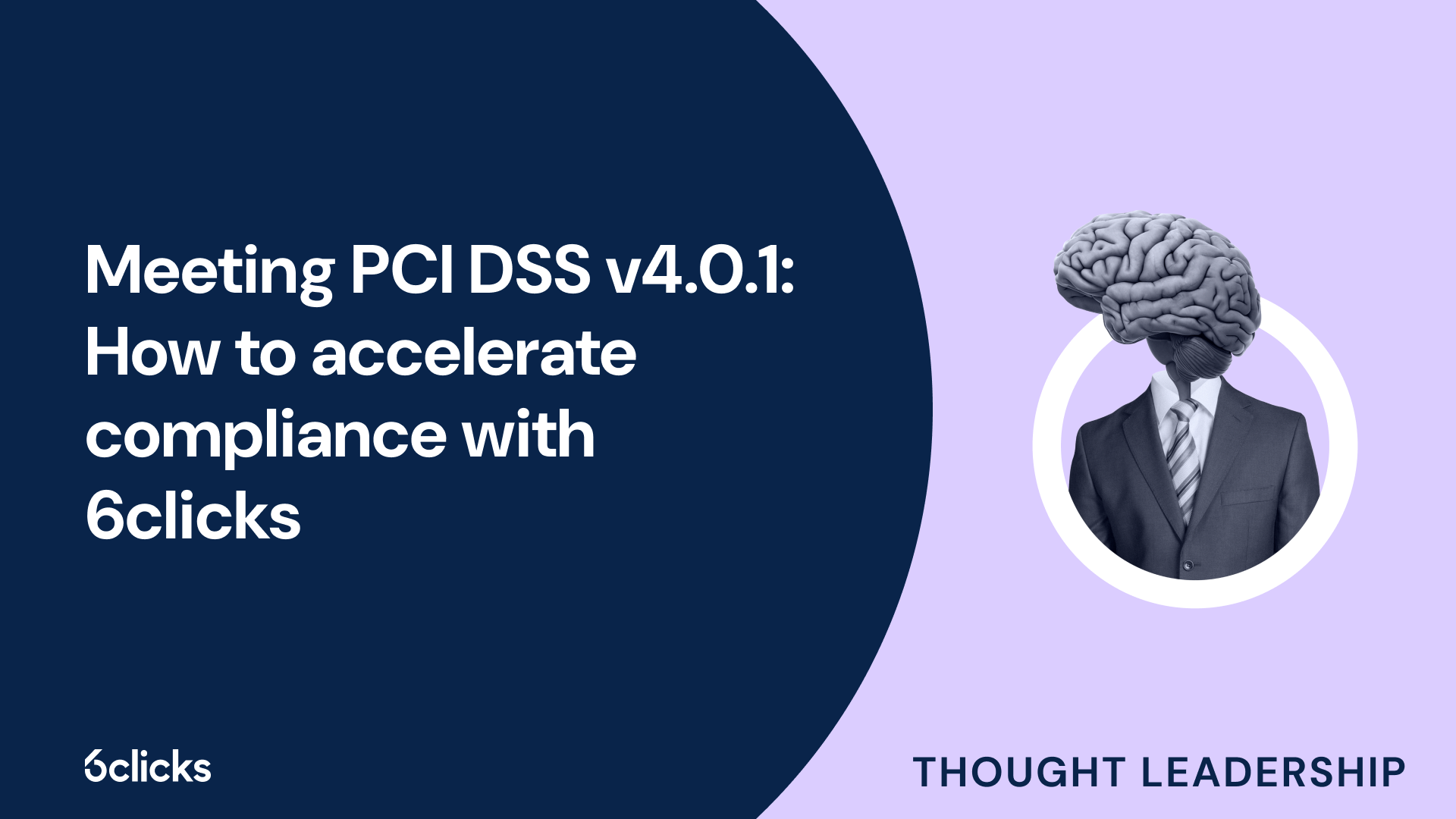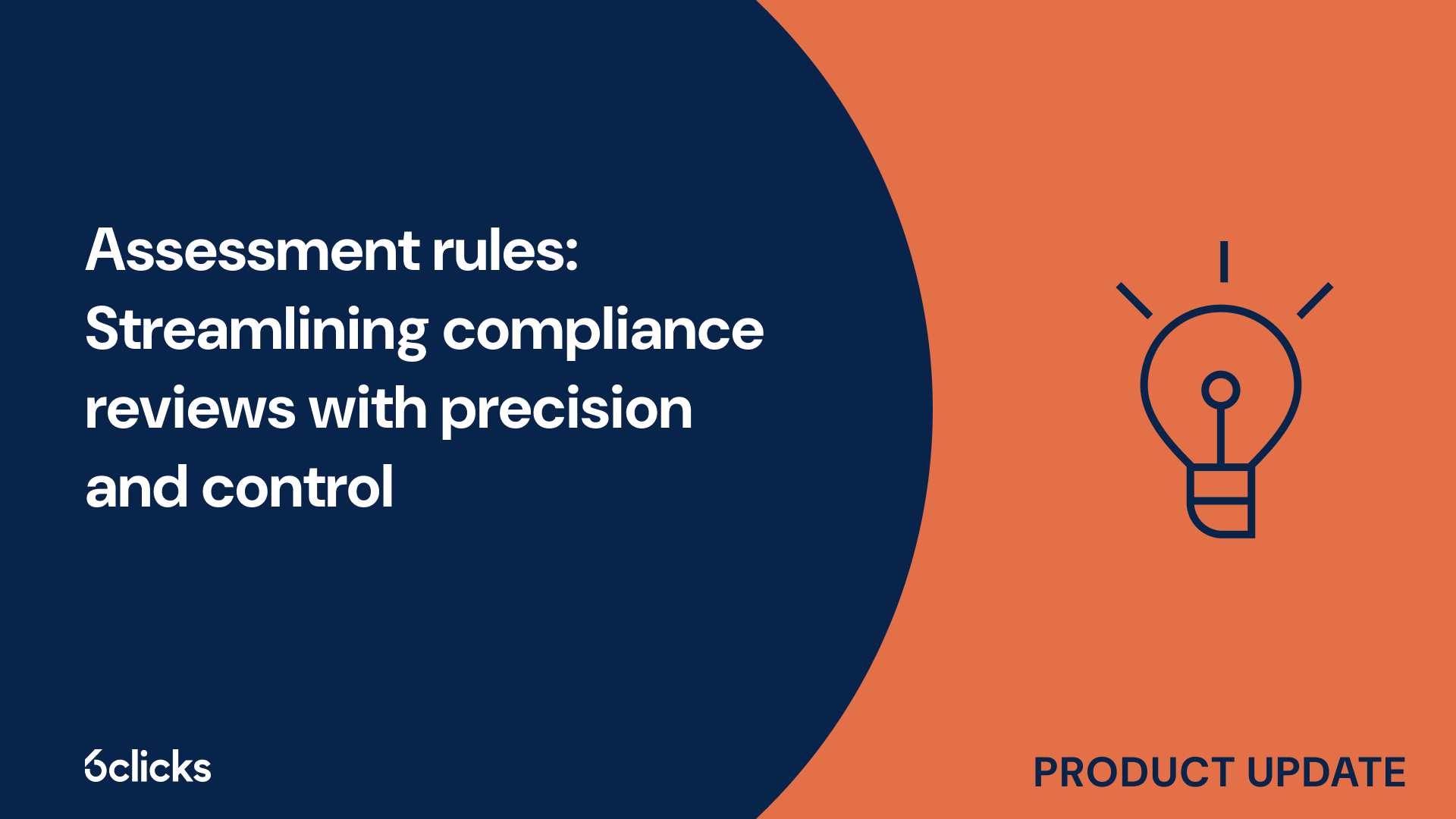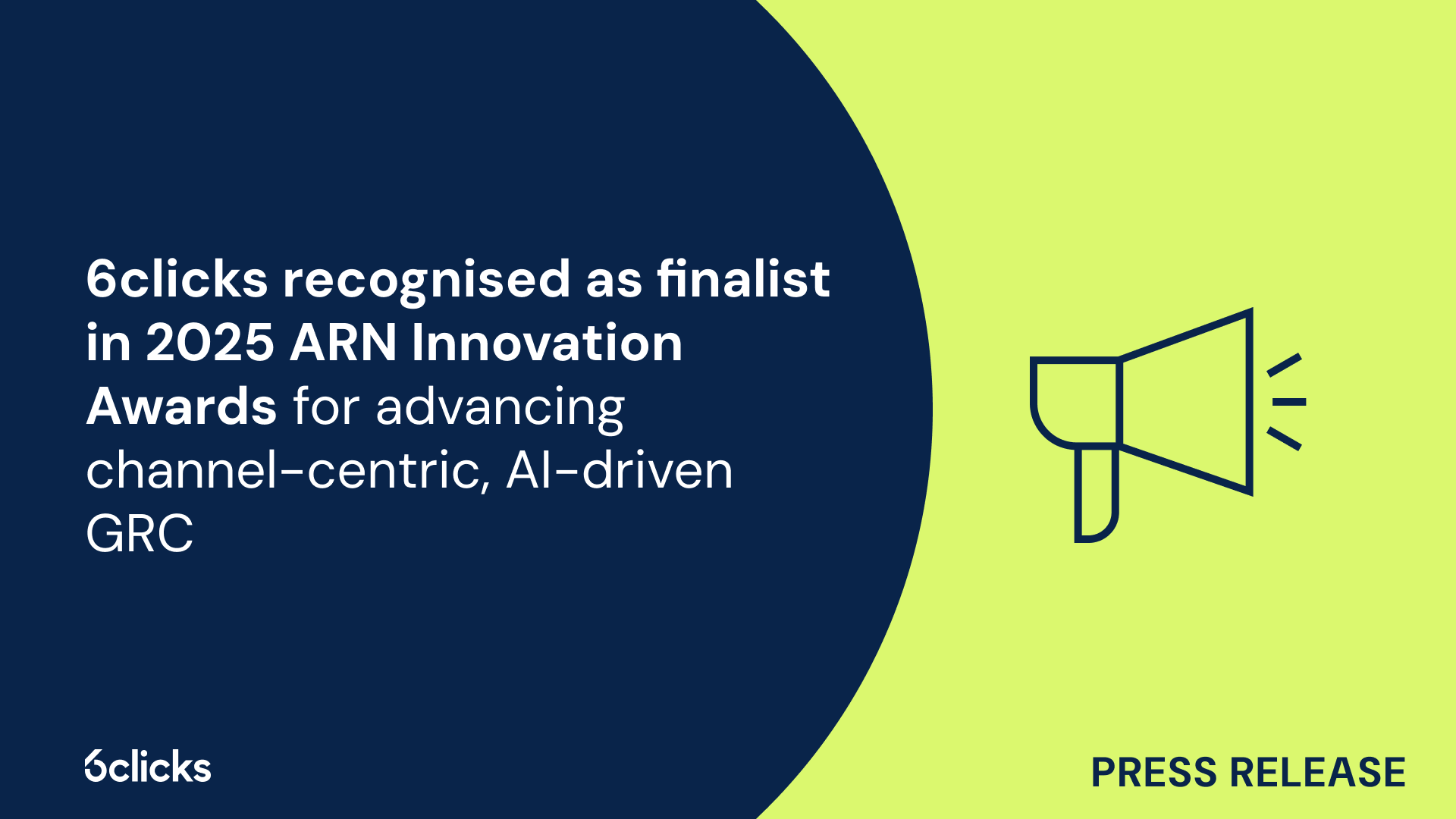The GRC buyer’s guide for 2025: Building resilience with AI-powered, federated solutions
Discover the ultimate GRC buyer's guide for 2025! Uncover how AI-powered, federated solutions transform compliance and security management for industries like government, aerospace, banking, and more. Learn about centralized control, continuous compliance, and advanced cyber GRC capabilities. Download now!
-1.png?width=200&height=249&name=Group%20193%20(1)-1.png)
The GRC buyer’s guide for 2025: Building resilience with AI-powered, federated solutions
What is the IRAP assessment process?
The Information Security Registered Assessors Program (IRAP) is an Australian government initiative to ensure the protection of sensitive information and systems through independent security assessments. IRAP assessors evaluate the effectiveness of security controls in government and private sector organizations, helping them manage security risks, comply with government standards, and maintain a strong security posture against growing cyber threats.
Overview of the IRAP assessment process
The IRAP assessment is a key part of Australia’s cybersecurity strategy, ensuring organizations handling sensitive data meet strict security standards.
The process includes two stages:
1. High-level assessment: Assesses the organization’s security commitment and overall posture through document reviews and interviews with key personnel.
2. Detailed assessment: Examines the effectiveness of security controls, systems, and infrastructure to identify vulnerabilities.
Benefits of IRAP assessment
- Risk mitigation: Identifies security risks and ensures controls meet government standards.
- Improved security: Highlights areas for improvement and offers recommendations to strengthen security practices.
- Compliance: Demonstrates adherence to government security requirements.
- Confidence: Independent assessors provide assurance that security measures are robust and reliable.
Who can undertake an IRAP assessment?
The requirements to become an IRAP assessor are designed to ensure the highest level of expertise in evaluating cybersecurity posture and identifying security risks. IRAP assessors must meet specific qualifications and demonstrate extensive experience in cybersecurity. These professionals play a critical role in ensuring organizations adhere to Australian Government security standards. Key requirements include:
- ASD certification: IRAP assessors must be ASD-certified ICT professionals with a strong background in ICT, security assessment, and risk management.
- Expert knowledge: They must possess detailed knowledge of Australian Government information security compliance requirements, enabling them to evaluate how well organizations meet these standards.
- Understanding security controls and risk management: Assessors need a deep understanding of security controls, risk management activities, and cybersecurity strategies to identify vulnerabilities and recommend effective mitigation measures.
- Experience in conducting independent assessments: They must have the qualifications and skills to independently assess an organization’s cybersecurity posture, ensuring assessments align with government policies and security standards.
The IRAP assessment process
The IRAP assessment involves several stages:- Scoping: Initial meeting to define the assessment’s scope.
- Data collection: Gathering information on security controls and practices.
- Evaluation: Reviewing security standards, identifying vulnerabilities, and comparing practices with government policies.
- Reporting: Providing a detailed report with findings and recommendations for improvement.
The role of Australian government agencies
Government agencies play an essential role by working with IRAP assessors to define assessment scopes, set security objectives, and ensure compliance with protection levels set by the Australian Signals Directorate (ASD). These agencies help identify vulnerabilities and improve security through continuous risk management activities.
Ensuring compliance with protection levels under the IRAP framework
Ensuring compliance with protection levels under the IRAP framework involves a thorough process of evaluating and implementing security controls to meet Australian Signals Directorate (ASD) standards. Government agencies follow a series of steps to assess their security posture, identify vulnerabilities, and implement the necessary measures to achieve compliance.
Key steps include:
- Collaboration with IRAP assessors: Agencies work with IRAP assessors to define the scope of the assessment and set clear security requirements and objectives. This targeted approach helps identify gaps or vulnerabilities in the agency’s security posture.
- Evaluation of existing security controls: Agencies compare their existing security controls against ASD’s protection levels, which are designed to address varying security risks and threats. This step helps identify weaknesses or non-compliance areas.
- Implementation of security controls: Based on the evaluation, agencies implement the necessary security controls, which may include updating existing measures, adopting new practices, or improving areas like access control, authentication, data protection, and incident response.
- Adherence to IRAP framework guidelines: Throughout the process, agencies must comply with common security standards, relevant cybersecurity policies, and engage ASD-certified ICT professionals to ensure assessments and implementations meet the required security levels.
Security controls and risk management
Effective security controls and risk management are central to the IRAP assessment. Government agencies assess their security measures, identify gaps, and develop plans to improve security by implementing new technologies, updating policies, and enhancing incident response protocols.
Identification of security risks and vulnerabilities
In an IRAP (Information Security Registered Assessor Program) assessment, identifying security risks and vulnerabilities involves a thorough evaluation of an organization’s security posture. The goal is to uncover potential threats and weaknesses that could compromise sensitive information or disrupt services.
Steps in identifying risks and vulnerabilities include:
- Independent penetration testing: Simulating real-world cyber attacks to identify exploitable vulnerabilities. This test helps assess the effectiveness of existing security controls and provides insights into potential risks.
- IRAP/ISM assessment: Ensuring compliance with Australian government security controls, covering areas such as access control, incident response, encryption, and physical security.
Salsa, with its extensive experience in conducting penetration tests and IRAP/ISM assessments, plays a crucial role in identifying and mitigating security risks. With a team of skilled cybersecurity professionals and in-depth knowledge of government policies, Salsa delivers effective security outcomes, ensuring a secure platform for government and other clients.
Evaluation of existing security posture
Evaluating an organization's existing security posture is a critical step in establishing a strong cybersecurity strategy. This process involves assessing the organization's current security controls, practices, and policies to identify vulnerabilities that could be exploited by cyber threats.
Important components of evaluating security posture include:
- Cybersecurity team involvement: A team of experts reviews various aspects of the security framework, including security policies, procedures, technologies, and infrastructure. They may also assess incident response plans, access controls, encryption methods, and physical security measures.
- Identifying gaps: The team uses the Statement of Applicability to compare existing security measures against industry best practices or regulatory compliance guidelines, identifying areas where improvements are needed.
- Developing solutions: After identifying gaps, the team proposes measures to enhance security. These could include implementing new technologies, updating policies and procedures, providing employee training, or improving incident response capabilities.
This evaluation helps organizations identify security weaknesses and take necessary actions to improve their overall security posture.
Establishing appropriate security controls
In an IRAP assessment, establishing effective security controls involves assessing the organization's current security posture to identify vulnerabilities and areas for improvement. Key steps include:
- Reviewing security measures: A thorough review of the organization's existing security policies, incident response plans, access controls, encryption methods, and physical security measures to ensure all potential security risks are covered.
- Gap analysis: The Statement of Applicability is used to compare current security measures with industry standards or regulatory requirements. This helps pinpoint specific gaps where security controls may be lacking or non-compliant.
- Solution design: Once gaps are identified, the next step is to design solutions to address them. This may include introducing new security technologies, refining policies and procedures, or enhancing employee security training programs.
- Technical, people, and process measures: The organization may need to implement technical solutions (e.g., firewalls, intrusion detection systems), ensure employees are well-trained in security best practices, and update operational processes to align with compliance requirements.
Conducting risk management activities
Risk management is a crucial element of the IRAP assessment process, helping organizations identify, assess, and mitigate cybersecurity risks to ensure compliance with security standards. The process involves:
- Risk identification: Identifying potential cybersecurity risks related to infrastructure, applications, systems, and processes, including risks like data breaches, unauthorized access, and cyberattacks.
- Risk analysis: Analyzing each identified risk to determine its potential impact and likelihood, helping to prioritize which risks require immediate attention and which can be managed over time.
- Risk evaluation: Evaluating risks based on the organization’s risk tolerance and the potential consequences of each risk, helping to decide which risks need immediate treatment and which can be accepted or managed through mitigation strategies.
- Risk treatment: Developing and implementing risk treatment plans that may involve enhancing existing security measures, adopting new technologies, or changing policies to minimize the likelihood of security incidents.
- Risk monitoring: Continuously monitoring the risk environment and reviewing the effectiveness of implemented controls to ensure ongoing protection against evolving threats. This includes regular risk assessments to keep pace with new vulnerabilities.
Cloud services and communications technology in IRAP assessments
Cloud services and communications technology are critical components of an organization’s overall security strategy. The IRAP assessment ensures these areas meet the required security standards and effectively manage risks. The assessment focuses on:
- Cloud services: The security of cloud platforms used for data storage, processing, and transmission is assessed, including reviewing provider security practices, data encryption, and how data is accessed and protected in the cloud environment.
- Communications technology: The security of communications technology, including mobile devices and data transmission channels, is evaluated. This includes reviewing encryption protocols, secure access controls, and the ability to prevent unauthorized access or data breaches.
Specific security controls:
- Protection of data in transit and at rest: Ensuring encryption is in place to protect sensitive data both during transmission and while stored in cloud systems.
- Access controls and authentication: Reviewing the implementation of multi-factor authentication, role-based access controls, and other mechanisms to secure cloud services and communication platforms from unauthorized access.
- Incident response and recovery: Evaluating the organization’s ability to respond to security incidents involving cloud services and communications technology, including the effectiveness of disaster recovery and business continuity plans.
- Compliance with industry standards: Ensuring the organization adheres to relevant cybersecurity regulations and industry standards to guarantee that cloud services and communications technologies are secure and compliant with government requirements.
By addressing these factors, organizations can improve their cybersecurity posture, reduce risk, and meet the stringent requirements of the IRAP framework.
Summary
The IRAP (Information Security Registered Assessors Program) is an Australian government initiative designed to ensure the security of sensitive information through independent assessments. The assessment process involves two stages: a high-level review of an organization's overall security posture and a detailed evaluation of its security controls, systems, and infrastructure. Key steps include collaboration with IRAP assessors to define security objectives, evaluate existing measures, identify gaps, and implement necessary controls to meet Australian Signals Directorate (ASD) protection levels. The process also involves conducting risk management activities to identify, analyze, and treat potential cybersecurity risks.
Through the IRAP assessment, organizations can improve their security posture by mitigating risks, enhancing compliance with government standards, and strengthening cybersecurity practices. The assessment also evaluates cloud services and communications technology to ensure data protection, secure access, and encryption. By adhering to the IRAP framework, organizations can safeguard sensitive data, demonstrate compliance, and maintain trust with stakeholders while adapting to emerging security challenges.







